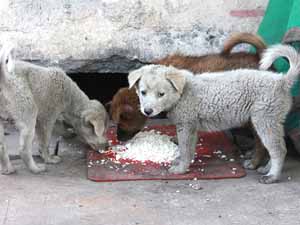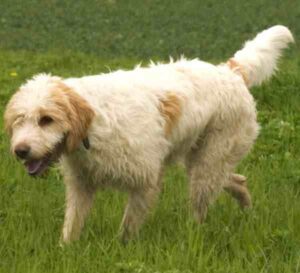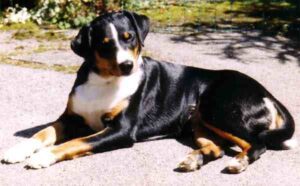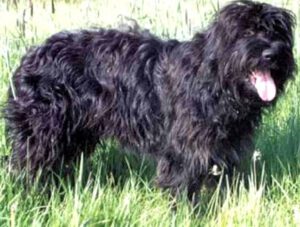The Berger Picard dog is a rare breed of herding dog. They were nearly became extinct after both World War I and World War II, and still remain a rare breed. It is also known by some other names such as Picard, Berger de Picardie, Picardy Shepherd and Picardy Sheepdog.
The breed was originated from Picardy in France. The breeding stock of the Berger Picard dog was decimated by the ravages of World War I and World War II. With its population concentrated on the farms of north-eastern France, trench warfare in the Somme reduced the breed to near extinction. The prevalence of the breed worldwide remains limited, even in its native country.[1]
There are approximately 3500 dogs in France. And in the year of 1955, the Berger Picard dog breed was accepted by the Fédération Cynologique Internationale (FCI).
There are approximately 400 Berger Picard dogs in Canada and the United States. And Germany has approximately 500 of this breed.
The Berger Picard Club Canada and the Berger Picard Club of America were formed to help promote and protect this breed.
On 1st July 2015, the Berger Picard dog was fully recognized in the herding group by the American Kennel Club. The breed is also in the herding group category of the Canadian Kennel Club.
Berger Picard Dog Characteristics
The Berger Picard dogs are very beautiful, medium sized dogs. They are well muscled, slightly longer than tall with a tousled yet elegant appearance.
They have naturally erect ears which are high set and quite wide at the base. The eyebrows of these dogs are thick, but do not shield their dark frank eyes.
These dogs are known for their smile. Their natural tail normally reaches to the hock and is carried with a slight J-curve at the tip.
They have a weather-proof coat which is harsh and crisp to the touch, not excessively long with a minimal undercoat. Their common coat coloration is fawn and brindle with a range of shade variations.
The Berger Picard dogs are medium in size. Average body height of the mature dog is between 22 and 26 inches at the withers. And their average live body weight is between 23 and 32 kg.

Temperament
The Berger Picard dogs have a lively, intelligent personality and a sensitive and assertive disposition that responds quickly to obedience training.
They are easygoing and mellow, but can be reserved towards strangers. They require a lot of socialization during the first two years of their lives.
These dogs are energetic and hard working, alert and are not excessive barkers. And some Berger Picard dogs are notoriously picky eaters.
These dogs also have a well-developed sense of humor, making them an endearing companion, and they continue to be used very effectively as both sheep and cattle herders in their native land and elsewhere.
The Berger Picard dogs require human companionship, just like many other herding dog breeds. Since they can be demonstrative to their owners and enthusiastic towards other animals, formal obedience training and positive socialization is important.
Lifespan
Average lifespan of the Berger Picard dog is between 12 and 14 years.
Feeding
How much a mature dog eats depends on it’s size, age, build, metabolism and activity level. Dogs are individuals, just like people, and they don’t all need the same amount of food.
The Berger Picards are medium-sized dogs. So, their diet should be formulated for a medium-sized breed with average to high exercise needs. You can consult with a vet in your area for better recommendation.
Caring
Taking good care of the animals is very important for raising Berger Picard dogs. They can compete in agility trials, tracking, obedience, showmanship, Schutzhund, flyball, lure coursing, French ring sport and herding events.
Herding instincts and trainability can be measured at noncompetitive herding tests. Berger Picards exhibiting basic herding instincts can be trained to compete in herding trials.
The Berger Picard dogs can do surprisingly well in city life, despite being able to ready to work outdoors. But they require to have enough energy-releasing exercise to live city life.
They are very loyal and generally enjoy a lot of attention and may suffer from separation anxiety. This is actually not a breed created to live outside year round.
The Berger Picard is a low maintenance dog. The rough, tousled coat can mat if not brushed on a regular basis. But the coat doesn’t require any special care to yield it’s rustic appearance.
Health
The Berger Picard dogs are generally healthy. But like all other dog breeds, they are also prone to certain health conditions.
Their common health problems include hip dysplasia and progressive retinal atrophy (PRA). Always keep good contact with a vet in your area.
| Breed Name | Berger Picard |
| Other Names | Picard, Berger de Picardie, Picardy Shepherd and Picardy Sheepdog |
| Breed Size | Medium |
| Height | Between 22 and 26 inches at the withers |
| Weight | Between 23 and 32 kg |
| Good as pets | Yes |
| Climate Tolerance | All climates |
| Color | Fawn or brindle |
| Lifespan | Between 12 and 14 years |
| Good for children | Yes |
| Rarity | Rare |
| Country of Origin | France |






